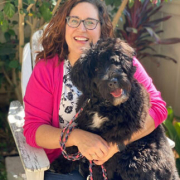Celiac Food Writer Reads Restaurants the Riot Act
 Restaurants site cost, ingredient sourcing time and effort as the greatest obstacles to serving gluten-free diners. Lindsey Yeakle, Gluten-Free Food Service (GFFS) Program Manager, Food Safety, for the nonprofit Gluten Intolerance Group (GIG), is here to bust those myths!
Restaurants site cost, ingredient sourcing time and effort as the greatest obstacles to serving gluten-free diners. Lindsey Yeakle, Gluten-Free Food Service (GFFS) Program Manager, Food Safety, for the nonprofit Gluten Intolerance Group (GIG), is here to bust those myths!
- Lindsey Yeakle, modernrestaurantmanagement.com 1
Over the last decade, demand for gluten-free foods has grown by an eye-popping 200 percent with two out of 10 Americans seeking gluten-free options when dining out.
While many restaurants once viewed gluten-free dining as a passing fad, there is growing awareness that demand for gluten-free options is more than a trend. Eager to tap into a growing market, more and more restaurants are adding gluten-free items to their menus.
At the same time, restaurant owners may be concerned about the time, expense, and profitability of serving gluten-free dishes. In most cases, these fears are based on misconceptions about gluten-free ingredients and food preparation. With many restaurants evaluating their policies and procedures to meet social distancing requirements, now is the perfect time to dispel three of the most common myths and add gluten-free dishes to your menu.
Myth #1: Serving a Gluten-Free Menu Is Too Expensive
One of the most persistent myths about gluten-free dining is that you need a separate, dedicated kitchen to safely prepare gluten-free food. The reality is that you can adapt existing spaces with a minimal investment of money and effort. Establishing a dedicated prep space and purchasing separate pots and pans is a great place to start. You will also need to invest in a few pieces of dedicated equipment like toasters and cutting boards.
While some dedicated equipment is necessary, not everything has to be separate. For example, you can use the same oven to bake gluten-free and traditional pizzas. Using a disposable pan to bake gluten-free pizzas is an inexpensive way to prevent crust contact without sacrificing taste. You can also use the same salamander to broil meats for gluten-free dishes and other items. Because the heat comes from the top and there’s no circulating air, there is minimal risk of cross-contamination. Nor do you need a dedicated pan to broil meats, as long as you can run it through a dishwasher to remove any gluten particles and sterilize it.
Myth #2: Gluten-Free Ingredients Are Hard to Find
Another prevalent myth is that gluten-free ingredients are hard to find. In truth, most suppliers, particularly large ones like Sysco and US Foods, carry a variety of gluten-free products. While finding products that give your dishes the desired taste and texture can take some trial and error, many vendors are happy to provide samples of gluten-free products so that you can taste different options and see what works for your menu.
Gluten-free products have come a long way when it comes to taste and texture. Many pastas and baked goods like cakes and muffins are indistinguishable from their gluten-containing counterparts. In other cases, removing gluten really does make a difference. For instance, it’s very difficult to duplicate the texture of breads and pizza crusts that contain gluten, because this protein is what gives dough its elasticity.
Fortunately, differences in texture aren’t necessarily a deal breaker. Most diners who adopt a gluten-free diet expect to find some differences and are more than willing to pay a little extra for good-tasting food that is safe to eat. This flexibility allows restaurants to absorb any costs associated with specialty ingredients by marking up gluten-free dishes.
Although it’s relatively easy to find gluten-free products, some items are trickier than others. Oats are inherently gluten-free but they are vulnerable to cross-contamination unless they are grown, stored, and shipped in dedicated fields, silos, and trucks or railway cars. Other foods like beer and soy sauce often contain gluten, but it is possible to find gluten-free varieties with a little digging.
Myth #3: It’s Not Worth the Time and Effort to Serve Gluten-Free Dishes
Many restaurants assume that it takes months of effort to launch gluten-free menu options, but this is another misconception. With a little foresight, restaurants can roll out a gluten-free menu in as little as two weeks. Setting up dedicated prep stations takes very little time and some steps, like printing new menus, can be postponed or eliminated altogether provided your staff can answer questions about your gluten-free offerings.
A well-trained staff can help you reassure customers that you know what you’re doing while poorly prepared staff can set off alarm bells for diners who depend on a gluten-free diet to stay healthy. Train front-of-house staff to answer questions about your gluten-free dishes and make sure your kitchen staff understand proper procedures for preventing cross-contamination.
If you’re serving gluten-free dishes, have written procedures for each phase of food preparation. A binder of handwritten notes, taken during a training session, can provide an invaluable reference for line cooks and other kitchen staff. You do want to emphasize that staff need to follow established procedures, regardless of their personal beliefs about gluten sensitivity.
Validation can provide valuable support in creating procedures and developing a training program. The validation process will clear up any misconceptions your staff has and inspire confidence by removing that element of the unknown. Assessors can also steer you toward quality gluten-free products and teach you useful tips like storing gluten-free ingredients on the top shelves of refrigerators, freezers, and dry storage. Using gluten-free pasta that is a different shape from other varieties is another helpful practice.
- With more diners adopting a gluten-free diet out of medical necessity or other health reasons, now is a great time to get started on launching your own gluten-free menu. With a modest investment of time and energy, you can earn the trust and loyalty of gluten-free diners while tapping into a growing and increasingly profitable market.

Lindsey Yeakle
Lindsey Yeakle, Gluten-Free Food Service (GFFS) Program Manager, Food Safety, for the nonprofit Gluten Intolerance Group (GIG), has a culinary history working at four-star and four-diamond rated restaurants, and she founded Alligator Pear Personal Chef Service. A celiac disease diagnosis encouraged Yeakle to attend culinary school at Indiana University of Pennsylvania Academy of Culinary Arts to learn how to design dishes for all types of dietary needs and restrictions. In June 2016, Yeakle decided to use her background and education to help the gluten-free community by working with GIG. @gffoodservice • Linkedin • Website













